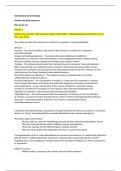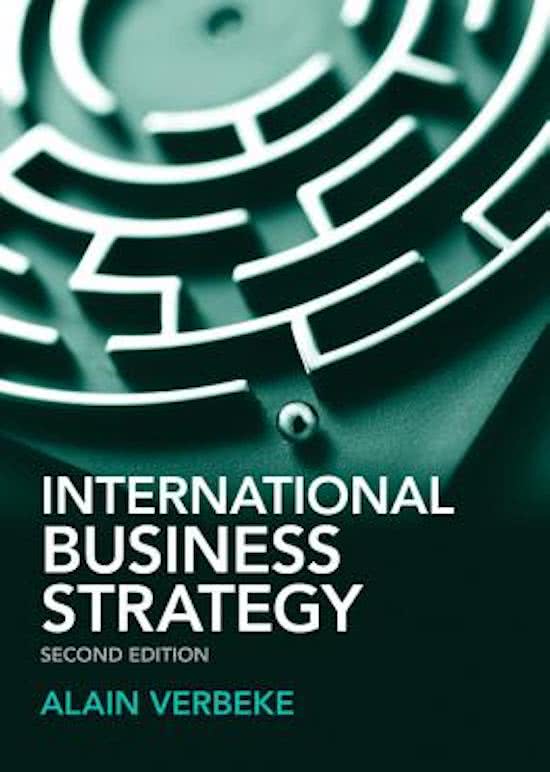International Level Strategy
Articles and book summary
Ella van de Loo
Lecture 1
Benito, G.R.G. (2015), "Why and how motives (still) matter", Multinational Business Review, Vol. 23
No. 1, pp. 15-24
This article describes the relevance of motives for companies’ internationalization.
Abstract
Purpose – The article provides a discussion of the relevance of motives for companies’
internationalization.
Design/methodology/approach – Conceptual discussion building on established
classifications of motives of internationalization, which distinguish between market-seeking,
efficiency-seeking, resource-seeking and strategic asset-seeking motives.
Findings – The analysis demonstrates that important issues in companies’ internationalization
differ systematically across different types of motives, which implicates that motives remain
relevant when analysing various aspects of the internationalization of the firm. Motives are also
useful elements for theory building in international business.
Research limitations/implications – The analysis is purely conceptual and is not further
substantiated by empirical evidence.
Practical implications – The classification of motives is a useful tool for companies to analyze
their strategic alternatives and actions, especially with regard to performance measurement.
Social implications – A clear classification of the various motives for companies’ foreign
activities is essential for formulation of sound policies about attraction/stimulation and
regulation of companies’ inbound and outbound internationalization.
Originality/value – The article demonstrates the importance of retaining a clear classification
of motives as a basis for further development of a theory of firms’ internationalization behavior.
Keywords – Internationalization of the firm, FDI, Motives, Internalization theory,
Internationalization process
Companies internationalization is purposeful and goal-oriented, this does not say that it is successful
always. So, a firms’ internationalization is inextricably linked to the motives underlying it.
This paper argues that motives:
- Remain useful as a basis for identifying important location and internationalization factors
- That they characteristically relate to different sectors and industries
- Theat they typically involve different types of (value) activities
- That they have fundamental implications for how to assess performance
Conceptualization of firms’ internationalization are bound to be imprecise, or inadvertently offered as
general while in reality being partial. Conversely, unfound claims of generality tend to result in
forgetting to (or even avoiding) to critically examine the boundary conditions of a theory, perspective
or framework.
Different motives:
- Market-seeking; companies that venture abroad to find customers
, - Efficiency-seeking; companies that venture abroad to lower their costs of performing
economic activities, and/or that aim at rationalizing their already existing operations in
various locations.
- Resource-seeking; companies that venture abroad to access resources that are not readily
available at home or that can be obtained at a lower cost abroad.
- (strategic) Asset seeking; companies that venture abroad to obtain strategic assets (tangible
or intangible), which may be critical to their long-term strategy, but that are not available at
home.
Motives are typically called: ‘foreign direct investments’ = FDIs.
Companies may replace FDI with exporting and importing activities. Another possibility would be to
enter an agreement with another party to carry out the business. Examples are: a licensing contract
(exp; to use intellectual property) or engaging in close collaboration with another party (exp;
alliance).
Important to realize that motives per se don’t provide a sufficient justification for either FDI, or any
other form of business activity across borders. Exp: a company that exports is equally market-seeking
as a company that produces abroad to service a local market.
Motives clarify above all the why question in international business.
Motives and the where of internationalization
Since market entry is costly and risky, and market knowledge is crucial for succeeding in a market,
companies also tend to value proximity to their new markets, especially in the early phases of their
expansion abroad.
Distance is likely to be significant for companies that sell to other companies and not end cnosumers,
because closeness is crucial in business-to-business relationships.
When a company decides to go abroad, the decisive location factors change to cost levels and
availability of human resources. Since distance typically translates to transportation and management
costs, proximity might also be an important consideration by efficiency-seeking companies.
In terms of location choices:
- Resources-seeking firms: often more constrained in their choices; resources are not evenly
distributed geographically (and hence, politically, socially, etc.)
- Firms that seek opportunities to develop or acquire new strategic assets: look for factors such
as the existence of vibrant clusters, a high level of development, urban centres etc. The
crucial point is that strategic asset seeking is forward-looking. It is about developing new
resources and capabilities that can generate future streams of revenue, not exploiting already
existing ones.
Motives and the how of internationalization
How to organize and operate their international business activities. According to the
internationalization theory: the choices on how international business activities are carried out are
about finding the most efficient (cost minimizing) way of operating abroad.
Internationalization theory argues that he in-house option is superior only in circumstances where
the alternatives either do not provide a social context among those involved in an activity that is
advantageous to its performance (exp could be work that is non-programmed and that requires a
high level of interaction between people), or entails using proprietary assets and resources (firm-
specific advantages) whose value could be exploited by outside parties without due compensation.
These issues also play out in a differentiated manner across different internationalization motives.
, - Market-seeking firms: basis for international expansion is typically that they own brands or
trademarks that are, or can be made, valuable when expanding in new markets. Expanding
abroad by setting up own subsidiaries is a way of safeguarding brand assets.
- Efficiency-seeking firms: often make substantial investments in production and logistical
systems and hardware to gain economies of scale, scope and time. Such investments typically
result in assets that are tailor-made to the specific needs of the company and have little value
in alternative uses. That makes them vulnerable to hold-up and under-investment problems if
not safeguarded under common ownership.
- Resources-seeking firms: experience challenges regarding hold-up as well as under-
investment that seem similar to those of efficiency-seeking firms. Difference with efficiency-
seeking firms is that the risks they face often refer to the actions of governments and other
political actors in the countries where they operate. That leaves even the extra safeguards
provided by ownership at risk, since local authorities can seize assets without paying full
reparation.
- Strategic-asset seeking firms: focus on developing or acquiring new resources and capabilities
that provide future streams of revenue. Their key concern is often to get there first;
identifying and securing the focal assets before their competitors, which may prompt in
hurried actions with inadequate thought being given to due diligence. Firms that venture
abroad for strategic asset-seeking motives are likely to prioritize control over their foreign
operations, perhaps overriding other relevant concerns. (exp is acquiring start up AI firm
because of the importance of expanding the firms capabilities in AI)
Which motives are most prevalent in which industries for internationalization:
- Market seeking: typically in consumer goods and many services – industries where local
tastes, preferences and regulations are likely to matter much for firms’ product offers and
business strategies. Moreover, the should be a high degree of transferability of key elements
of the business strategy across markets.
- Efficiency-seeking: manufacturing industries, where firms have placed production abroad to
benefit from lower wages levels and other costs. Increasingly, services have also relocated.
- Resource-seeking: extractive industries such as minerals, oil and gas, but also forestry,
fisheries and agriculture. Can also be a vital element for firms whose essential strategy is to
control and coordinate vertical supply chains such as Starbucks or Zara.
- Strategic-asset seeking: occurring in many industries, but characteristic for high-tech such as
pharmaceuticals, computers and bio-technology.
Differences across motives regarding which value activities are typical for them: (/ performance
measurement)
- Market seeking: marketing and sales activities / (volume sold, sales growth, market share)
- Efficiency-seeking: manufacturing / (cost-profit margins, productivity -> input/output ratio)
- Resource-seeking: extraction and production / (input costs, price-cost margins, stability and
reliability of supplies)
- Strategic-asset seeking: R&D / (new patents, other intellectual property rights, introduction
of new processes and products)
The internationalization process of firms becomes more complex as it develops over time as they
build up experience and reduce their perceived uncertainty of operating abroad. Besides,
internationalization sometimes begins with inward activities such as buying machinery, which provide
future opportunities for outwardly oriented internationalization -> the movement is then one from
resource-seeking initially to market-seeking and other types of internationalization later on, but the
various motives often occur in parallel.
, Many companies demonstrated that their internationalization can be multifarious and driven by
several motives. Companies that aspire to compete globally are often inclined to pursue several
motives at the same time, and such firms have to calibrate their internationalization strategies
accordingly.
Lecture 2
Grant, R.M. 1991. Porter’s ‘Competitive advantage of nations’: An assessment. Strategic Management
Journal 12, 535-548
Abstract
Porter's Competitive Advantage of Nations is an important book which bridges the gap between
strategic management and international economics while contributing substantially to both. Porter's
analysis of the impact of national environment on international competitive performance
demonstrates the potential for the theory of competitive strategy to rescue international economics
from its slide into refined irrelevance, while simultaneously broadening the scope of the theory of
competitive strategy to encompass both the international dimension and the dynamic context of
competition. Nevertheless, the breadth and relevance of Porter's analysis have been achieved at the
expense of precision and determinacy. Concepts are often ill defined, theoretical relationships poorly
specified, and empirical data chosen selectively and interpreted subjectively.
Porter’s book – “The competitive advantage of nations” – addresses a question which lies at heart of
economic and managerial science: ‘Why do some social groups, economic institutions, and nations
advance and prosper?’.
The purpose of this paper is to assess the extent to which Porter provides a satisfactory answer to
this question, and, in doing so, the contribution which the book makes to international economics
and strategic management.
The book of Porter shifts the focus of attention from the performance of the firm to the performance
of the nation, the orientation of the analysis is positive rather than normative; the primary mission is
a predictive and explanatory theory of the international pattern of comp adv. In developing this
theory, Porter combines inductive and deductive analysis.
Method: analytical framework developed through studying competitive performance among 10
countries, each involving 5-9 industry cases.
The primary objective of the book is to explain why particular countries succeed in particular
industries. In Porters’ analysis, it is firms rather than nations which are the principal actors. The
influence of the nation on the international competitive performance of firms occurs through the
ways in which ‘a firm’s proximate environment shapes its competitive success over time’.
The role of the nation is the ‘home base’ which it provides for the firm. Firms typically develop within
a domestic context prior to expanding internationally, the home base plays a key role in shaping the
identity of the firm, the character of its management, etc, as well as having a continuing influence in
determining the availability and quality of the resources available to the firm.
This is a view of the nation as a set of contextual variables which influence the competitive
performance of firms and industries.
International competitive advantage is measured by ‘either the presence of substantial and sustained
exports to a wide array of other nations and/or significant outbound foreign investment based on
skills and assets created in the home country’.






